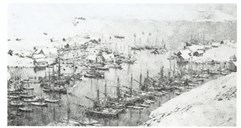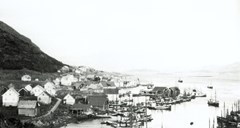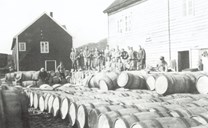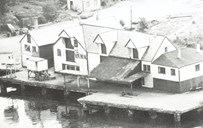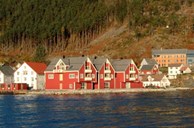The winter herring fisheries - the basis for growth
Kalvåg was developed only in the 1860s, first with boathouses and warehouses, and later on with quays and roads. It was the rich winter herring fisheries in the mid-19th century which formed the basis for the development. These fisheries were carried out with open boats, usually of the type with three pairs of oars, and a harbour in close proximity to the fishing ground was obviously an advantage. Whereas Kalvåg was located in the northern zone of the winter herring fisheries, the place was located in the southern waters of the cod fisheries which took place later on in the winter.
The winter herring fisheries culminated in the 1860s, when there could be as many as seven to ten thousand people gathered on the island and at Kalvåg. At Kalvåg many sailing ships came with barrels and salt and left with herring to the market. Some "jekts" even served as accommodation ships. By and by various facilities for making salt and processing fish sprang up around the bay. The sheltered harbour was a decisive factor in the ensuing development of the place. About 1870, there were as many as 52 salt-making facilities at Kalvåg with a production capacity of more than 35 000 barrels. 41 of these facilities were owned locally, whereas the remaining 11 - among the largest ones - belonged to merchants from Bergen and Stavanger. However, in 1873, the shoals of herring suddenly disappeared - never to return for many years - after coming to these coastal waters every year ever since 1811.
The accommodation arrangements during the fisheries
During the fisheries many extra workers were needed to process the herring and prepare the barrels for sale. Most of these workers were women from outside the village. At Kalvåg special accommodation facilities were established in connection with these fisheries as ordinary lodgings were hard to come by. Those who were lucky enough to secure a place at these houses had to live under cramped conditions, to put it mildly. The stuffy and foul air reeked with sweat, wet clothes, cooking and the smoke from the cod-liver-oil lamps. A lodging house measuring 11 by 7 metres with a height of 1.8 metres could accommodate as many as 120 people with their gear and belongings.
The development of the village
In the course of the 1860s, the village turned into a more permanent settlement. From 1890 to 1920 Kalvåg experiences another growth period, as the number of residences and people almost doubled. Most of the residences were located above the steamer quay. However, it was mostly warehouses that were built in this period. About 1920, there were approximately 80 warehouses of various categories around the bay of Kalvåg and on the island of Kalvøya. This growth resulted in a regulation plan for the land use of Kalvåg.
The fish trade experienced good times up until 1920, and very few warehouses and boathouses were built after that year. In the heyday of the fisheries it was not an uncommon sight in the harbour to see more than fifty ships with wholesale buyers of fish.
An improved steamer service also played its part in the Kalvåg upswing. A steamer quay was built fairly early, and the steamer routes were more frequent during the winter herring fisheries. Much transport of goods took place at the steamer quay. A post office was established at Kalvåg in 1861, a telegraph station in 1864, later on replaced by a telephone exchange. When Bremanger became a municipality of its own in 1866, Kalvåg was chosen to be the administration centre, and a municipal administration building was built some time after 1900. This building also served as a residence for the district doctor. Bremanger Sparebank (Savings Bank) established an office in Kalvåg in 1898. The road between Kalvåg and Steinset was completed in 1910. The harbour was dredged in 1911, a jetty was built, both leading to better harbour facilities. All these factors strengthened Kalvåg's position as a fishing village and a municipal centre.
Kalvåg after 1950
In the last couple of decades before 1960, the western coast experienced exceptionally rich winter herring fisheries. This meant a new boom for Kalvåg which increased its population from 260 to 391 between 1950 and 1960. However, the herring vanished after 1960. This led to a reduction in the settlements and population figures for the sparsely populated hamlets and villages along the coast, but Kalvåg and other built-up areas saw a different development. Kalvåg continued its growth to about 450 in the 1970s, but after that the population figures started its downward trend. In 1997, the number of people who lived in the built-up area was 380, and has been kept at about 350 up until 2000.
Structural changes in the fisheries with bigger fishing vessels and bigger catches had an impact on Kalvåg as a fishing harbour. The old warehouses were suitable for smaller catches of 40-50 hectolitres from the drift-net vessels. On the other hand, the modern fishing vessels with their catches of as much as 1000 hectolitres, require a far more modernized and mechanized apparatus for receiving such big quantities of fish. In recent years, the old warehouses have been rebuilt and refurbished to provide accommodation for tourists.


